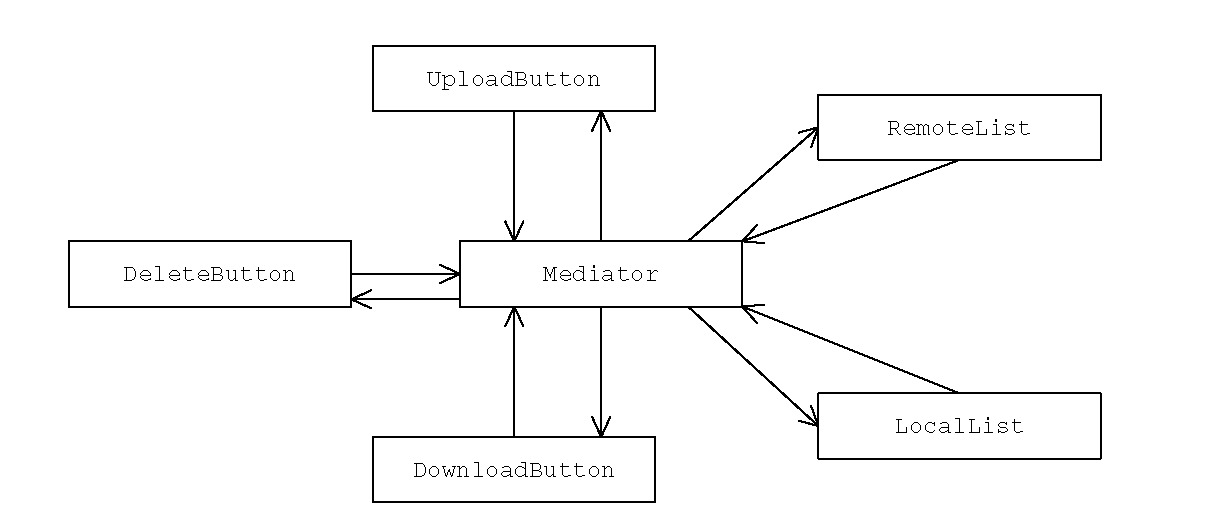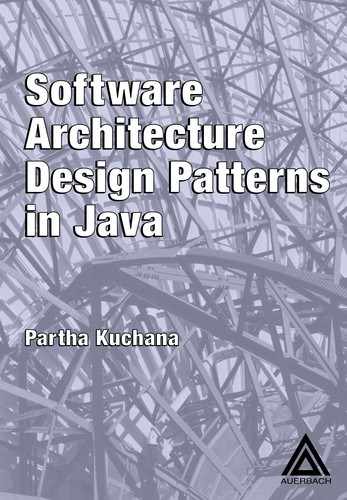31
MEDIATOR
This pattern was previously described in GoF95.
DESCRIPTION
In general, object-oriented applications consit of a set of objects that interact with each other for the purpose of providing a service. This interaction can be direct (point-to-point) as long as the number of objects referring to each other directly is very low. Figure 31.1 depicts this type of direct interaction where ObjectA and ObjectB refer to each other directly.
As the number of objects increases, this type of direct interaction can lead to a complex maze of references among objects (Figure 31.2), which affects the maintainability of the application. Also, having an object directly referring to other objects greatly reduces the scope for reusing these objects because of higher coupling.

Figure 31.1 Point-to-Point Communication in the Case of Two Objects

Figure 31.2 Point-to-Point Communication: Increased Number of Objects

Figure 31.3 Object Interaction: Mediator as a Communication Hub
In such cases, the Mediator pattern can be used to design a controlled, coordinated communication model for a group of objects, eliminating the need for objects to refer to each other directly (Figure 31.3).
The Mediator pattern suggests abstracting all object interaction details into a separate class, referred to as a Mediator, with knowledge about the interacting group of objects. Every object in the group is still responsible for offering the service it is designed for, but objects do not interact with each other directly for this purpose. The interaction between any two different objects is routed through the Mediator class. All objects send their messages to the mediator. The mediator then sends messages to the appropriate objects as per the application’s requirements. The resulting design has the following major advantages:
- With all the object interaction behavior moved into a separate (mediator) object, it becomes easier to alter the behavior of object interrelationships, by replacing the mediator with one of its subclasses with extended or altered functionality.
- Moving interobject dependencies out of individual objects results in enhanced object reusability.
- Because objects do not need to refer to each other directly, objects can be unit tested more easily.
- The resulting low degree of coupling allows individual classes to be modified without affecting other classes.
MEDIATOR VERSUS FAÇADE
In some aspects the Mediator pattern looks similar to the Façade pattern discussed earlier. Table 31.1 lists the similarities and differences between the two.
During the discussion of the Command pattern, we built two example applications. Let us revisit these applications and see how the direct object-to-object interaction can be avoided by applying the Mediator pattern.
Table 31.1 Mediator versus Façade
EXAMPLE I
The FTP client simulation application built in the previous chapter has the following list of UI controls (Table 31.2) in the client display.
Figure 31.4 depicts the interaction between different UI objects.
Let us consider the following minor enhancements to the existing application to make it more user-friendly:
- When the UI is first displayed, all buttons except the Exit button should be disabled.
- When a file name is selected from the JList control displaying the local file system:
- The Upload and Delete buttons should be enabled.
- Any selected item in the remote file system display should be deselected.
- The Download button should be disabled.
- When a file name is selected from the JList control displaying the remote file system:
- The Download and Delete buttons should be enabled.
- Any selected item in the local file system display should be deselected.
- The Upload button should be disabled.
Table 31.2 List of User Interface Objects and the Associated Functionality

Figure 31.4 Object Interaction
– After executing the necessary upload/download operation, the Upload, Download and Delete buttons should be disabled. Similarly, after deleting the specified file, the Delete button should be disabled along with any Upload and Download buttons that are currently enabled. Both the local and remote file system displays should get refreshed after a delete, download or upload operation.
Figure 31.5 shows the resulting object interaction.

Figure 31.5 Object-to-Object Communication with Increased Direct Reference to Each Other
As more controls are added for additional functionality such as file rename, FTP server connect, disconnect and others, the direct communication between objects creates a complex maze of references among objects. This greatly reduces the maintainability of the application.
The Mediator pattern can be used in this case for a more efficient design of the object interaction. Applying the Mediator pattern, an abstraction for the object interaction details can be created. This abstraction can be designed as a separate Mediator class as in Figure 31.6 and Listing 31.1.
From the Mediator class implementation it can be seen that the Mediator offers methods for different UI objects to register themselves with the Mediator. The set of object interactions to be executed when each UI control is activated (or clicked) is designed as a separate method inside the Mediator.
Client Usage of the Mediator
The client (Listing 31.2) creates an instance of the Mediator. Whenever a UI object is created, the client passes the Mediator instance to it. The UI object registers itself with this instance of the Mediator.
User Interface Objects: Mediator Interaction
Because all the object interaction details are removed from individual UI objects to the Mediator object, the processEvent method of each of these UI objects gets reduced to a simple call to an appropriate Mediator method (Listing 31.3). Figure 31.7 shows the UI object interaction after the Mediator pattern is applied.
| Mediator |
| btnUpload:UploadButton |
| btnDownload:DownloadButton |
| btnDelete:DeleteButton |
| localList:LocalList |
| remoteList:RemoteList |
| ________________________________ |
| registerUploadButton(inp_ib:UploadButton) |
| registerDownloadButton(inp_dnb:DownloadButton) |
| registerDeleteButton(inp_db:DeleteButton) |
| registerLocalList(inp_arl:LocalList) |
| registerRemoteList(inp_drl:RemoteList) |
| UploadItem() |
| DownloadItem() |
| DeleteItem() |
| LocalListSelect() |
| RemoteListSelect() |
Figure 31.6 Mediator

Figure 31.7 Object Interaction: Mediator as a Communication Hub
Listing 31.1 Mediator Class
class Mediator {
private UploadButton btnUpload;
private DownloadButton btnDownload;
private DeleteButton btnDelete;
private LocalList localList;
private RemoteList remoteList;
public void registerUploadButton(UploadButton inp_ib) {
btnUpload = inp_ib;
}
public void registerDownloadButton(
DownloadButton inp_dnb) {
btnDownload = inp_dnb;
}
public void registerDeleteButton(DeleteButton inp_db) {
btnDelete = inp_db;
}
public void registerLocalList(LocalList inp_arl) {
localList = inp_arl;
}
public void registerRemoteList(RemoteList inp_drl) {
remoteList = inp_drl;
}
public void UploadItem() {
int index = localList.getSelectedIndex();
String selectedItem =
localList.getSelectedValue().toString();
((DefaultListModel) localList.getModel()).remove(
index);
((DefaultListModel) remoteList.getModel()).addElement(
selectedItem);
btnUpload.setEnabled(false);
btnDelete.setEnabled(false);
btnDownload.setEnabled(false);
}
public void DownloadItem() {
…
…
}
public void DeleteItem() {
…
…
}
public void LocalListSelect() {
…
…
}
public void RemoteListSelect() {
localList.setSelectedIndex(-1);
btnUpload.setEnabled(false);
btnDelete.setEnabled(true);
btnDownload.setEnabled(true);
}
}
EXAMPLE II
During the discussion of the Command pattern, we built an application to add and delete items to a library item database. A given item can be part of one or more categories. Each Item object maintains a list of all categories which it is part of. Similarly, each Category object maintains a list of all items that currently are part of it. The class association diagram in Figure 31.8 depicts this relationship.
When an application has to deal with many items that belong to one or more categories, the object interactions can get complicated. The diagram in Figure 31.9 depicts a scenario where different Item and Category objects refer to each other directly.
The direct interaction between different Item objects and Category objects can be eliminated by moving the object interaction details out of the Item and Category classes to a separate Mediator class (Figure 31.10). The Mediator can be designed with the following two sets of methods:
- A set of methods to allow different Item and Category objects to register with the Mediator.
- A set of methods for adding and deleting items. The Mediator is respon-sible for implementing interactions between different objects as part of these methods.
Listing 31.2 Client FTPGUI Class
public class FTPGUI extends JFrame {
…
…
private Mediator mdtr = new Mediator();
public FTPGUI() throws Exception {
…
…
//Create controls
defLocalList = new DefaultListModel();
defRemoteList = new DefaultListModel();
localList = new LocalList(defLocalList, mdtr);
remoteList = new RemoteList(defRemoteList, mdtr);
pnlFTPUI = new JPanel();
…
…
//Create buttons
UploadButton btnUpload =
new UploadButton(FTPGUI.UPLOAD, mdtr);
btnUpload.setMnemonic(KeyEvent.VK_U);
DownloadButton btnDownload =
new DownloadButton(FTPGUI.DOWNLOAD, mdtr);
btnDownload.setMnemonic(KeyEvent.VK_N);
DeleteButton btnDelete =
new DeleteButton(FTPGUI.DELETE, mdtr);
btnDelete.setMnemonic(KeyEvent.VK_D);
…
…
}
…
…
}//end of class
The Mediator can maintain the Item-Category association in the item- CatAssoc instance variable. Item objects do not need to refer to Category objects directly. Hence an Item object does not need to maintain the list of Categories it belongs to and vice versa. Similarly, both add and delete operations are not required to be implemented by the Item and the Category classes.
The execute method of the AddCommand and DeleteCommand Command objects gets reduced to a call to the addItem and deleteItem Mediator methods, respectively.
Listing 31.3 Simplified UI Object Classes
…
…
class UploadButton extends JButton
implements CommandInterface {
Mediator mdtr;
public void processEvent() {
mdtr.UploadItem();
}
public UploadButton(String name, Mediator inp_mdtr) {
super(name);
mdtr = inp_mdtr;
mdtr.registerUploadButton(this);
}
}
class DownloadButton extends JButton
implements CommandInterface {
Mediator mdtr;
public void processEvent() {
mdtr.DownloadItem();
}
public DownloadButton(String name, Mediator inp_mdtr) {
super(name);
mdtr = inp_mdtr;
mdtr.registerDownloadButton(this);
}
}
…
…

Figure 31.8 Item-Category Association

Figure 31.9 Item-Category Object Interaction
| Mediator |
| itemCatAssoc:HashMap |
| registerItem(i:Item) |
| registerCategory(c:Category) |
| add(c:Category,i:Item) |
| delete(c:Category,i:Item) |
Figure 31.10 Mediator
PRACTICE QUESTIONS
1. Customer service representatives at some commercial banks handle queries from their existing and potential customers using an online chat application. At peak times, each representative may need to work with more than one customer simultaneously. Design this communication mechanism with a Mediator object between different User objects and Representative objects.
2. Implement the Example II application.
